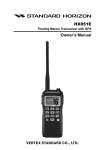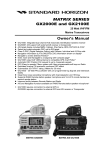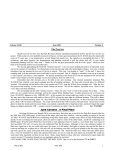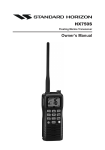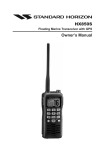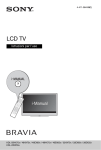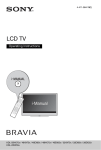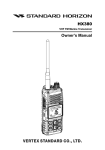Download HX751E Owner`s Manual - SUB-BSI
Transcript
HX751E Floating Marine Transceiver Owner’s Manual HX751E Page 1 TABLE OF CONTENTS 1. GENERAL INFORMATION .................................................................................................... 4 1.1 INTRODUCTION ......................................................................................................... 4 2. ACCESSORIES ...................................................................................................................... 5 2.1 PACKING LIST ........................................................................................................... 5 2.2 OPTIONS ..................................................................................................................... 5 3. ABOUT THIS RADIO ............................................................................................................ 6 3.1 ABOUT THE VHF MARINE BAND .......................................................................... 6 3.2 EMERGENCY (CHANNEL 16 USE) .......................................................................... 6 3.3 CALLING ANOTHER VESSEL (CHANNEL 16) ....................................................... 7 3.4 OPERATING ON CHANNEL 13 ............................................................................... 7 3.5 OPERATING ON CHANNEL 67 ............................................................................... 8 3.6 IMPORTANT SAFETY INFORMATION ....................................................................... 8 4. GETTING STARTED .............................................................................................................. 9 4.1 RADIO CARE .............................................................................................................. 9 4.2 BATTERIES AND CHARGERS ................................................................................. 9 5. CONTROLS AND INDICATORS ......................................................................................... 13 5.1 CONTROLS AND SWITCHES ................................................................................ 13 5.2 INDICATORS ............................................................................................................. 17 6. BASIC OPERATION ............................................................................................................ 19 6.1 PROHIBITED COMMUNICATIONS ......................................................................... 19 6.2 INITIAL SETUP ......................................................................................................... 19 6.3 RECEPTION .............................................................................................................. 19 6.4 TRANSMISSION ....................................................................................................... 20 6.5 USA, CANADIAN, AND INTERNATIONAL CHANNELS ....................................... 21 6.6 SIMPLEX/DUPLEX CHANEL USE .......................................................................... 21 6.7 KEYPAD LOCKING .................................................................................................. 21 6.8 PRESET CHANNELS (0 ~ 9): INSTANT ACCESS ................................................ 22 6.9 MEMORY SCAN ....................................................................................................... 23 6.10 PRIORITY SCAN ...................................................................................................... 24 6.11 DUAL WATCH ........................................................................................................... 25 6.12 TRIPLE WATCH ....................................................................................................... 25 6.13 MEASURING WATER TEMPERATURE ................................................................. 26 6.14 ENABLING S.O.S STROBE OPERATION ............................................................. 27 7. MENU (“SET”) MODE .......................................................................................................... 28 8. INSTALLATION OF OPTIONS ............................................................................................ 31 8.1 FBA-38 ALKALINE BATTERY CASE ..................................................................... 31 9. ATIS SETUP .......................................................................................................................... 32 9.1 ATIS CH GROUP ....................................................................................................... 32 9.2 ATIS CODE PROGRAMMING ................................................................................... 33 10. MAINTENANCE .................................................................................................................... 34 10.1 GENERAL .................................................................................................................. 34 10.2 TROUBLESHOOTING CHART ................................................................................ 34 11. CHANNEL ASSIGNMENT ................................................................................................... 35 12. SPECIFICATIONS ................................................................................................................. 37 12.1 GENERAL .................................................................................................................. 37 12.2 TRANSMITTER ......................................................................................................... 37 12.3 RECEIVER ................................................................................................................ 37 Page 2 HX751E Congratulations on your purchase of the HX751E! Whether this is your first portable marine VHF transceiver, or if you have other STANDARD HORIZON equipment, the STANDARD HORIZON organization is committed to ensuring your enjoyment of this high performance transceiver, which should provide you with many years of satisfying communications even in the harshest of environments. STANDARD HORIZON technical support personnel stands behind every product sold, and we invite you to contact us should you require technical advice or assistance. We appreciate your purchase of the HX751E, and encourage you to read this manual thoroughly, so as to learn and fully understand the capabilities of the HX751E. Technical support information and assistance can be obtained in Europe from our Website www.standardhorizon.co.uk NOTE Water resistance of the transceiver is assured only when the battery pack is attached to the transceiver and MIC/SP cap is installed in the MIC/SP jack. Attention in case of use This transceiver works on frequencies which are not generally permitted. For frequency allocation, apply for a licence at your local spectrum management authority. For actual usList of the practicable area age contact your dealer or sales AUT BEL BGR CYP CZE DEU DNK ESP EST FIN FRA GBR GRC HUN shop in order to get your transIRL ITA LTU LUX LVA MLT NLD ceiver adjusted to the allocated frePOL PRT ROM SVK SVN SWE CHE quency range. ISL LIE NOR HX751E Page 3 1. GENERAL INFORMATION 1.1 INTRODUCTION The HX751E is a Submersible Floating 6-Watt portable two way marine transceiver. The transceiver has all allocated USA, International, or Canadian channels. It has emergency channel 16 which can be immediately selected from any channel by pressing the [16/9] key. The HX751E includes the following features: Memory Scanning, Priority Scanning, ATIS Mode for Inland Waterways in Europe, Battery Saver, easy-to-read large LCD display, EEPROM memory back-up, Battery Life displayed on LCD, and a transmit Time-Out Timer (TOT). The HX751E transmitter provides a full 6 Watt of transmit power and also is selectable to 5, 2.5, and 1 Watt to assist the user in ensuring maximum battery life. The HX751E supports ATIS mode which is used in the inland waterways of Europe. Please contact your local PTT administration or Marine Authority to obtain your ATIS number. Page 4 HX751E 2. ACCESSORIES 2.1 PACKING LIST When the package containing the transceiver is first opened, please check it for the following contents: HX751E Transceiver CAT460 Antenna FNB-V99LI 7.4 V, 1150 mAh Li-Ion Battery Pack CD-39 Charger Cradle for HX751E NC-88C/U 230VAC Wall Charger for CD-39 CLIP-19 Belt Clip Owner’s Manual 2.2 OPTIONS MH-73A4B MH-57A4B VC-24 VC-27 CN-3 CD-39 FNB-V99LI FBA-38 NC-88C/U Speaker/Microphone Mini Speaker/Microphone VOX Headset Earpiece/Microphone Radio-to-Ship’s-Antenna Adapter Charger Cradle 7.4 V, 1150 mAh Li-Ion Battery Pack Alkaline Battery Case AC Wall Charger for the FNB-V99LI : “C” suffix is for use with 230 VAC (TypeC plug), and “U” suffix is for use with 230 VAC (Type-BF plug). Note: Before operating the HX751E for the first time, it is recommended that the battery be charged. Please see section “4.2.3 BATTERY CHARGING” for details. HX751E Page 5 3. ABOUT THIS RADIO 3.1 ABOUT THE VHF MARINE BAND WARNING The radio frequencies used in the VHF marine band lie between 156 and 158 MHz. The marine VHF band provides communications over distances that are essentially “Line of sight” Actual transmission range depends much more on antenna type, gain and height than on the power output of the transmitter. On a fixed mount 25 W radio transmission expected distances can be greater than 15 miles, for a portable 6 W radio transmission the expected distance can be greater than 5 miles in “Line of sight”. The user of a Marine VHF radio is subject to severe fines if the radio is used on land. The reasoning for this is you may be near an inland waterway, or propagation anomalies may cause your transmission to be heard in a waterway. If this occurs, depending upon the marine VHF channel on which you are transmitting, you could interfere with a search and rescue case, or contribute to a collision between passing ships. For channel assignments refer to page 35 section 11. 3.2 EMERGENCY (CHANNEL 16 USE) Channel 16 is known is the International Distress and Calling Channel. An emergency may be defined as a threat to life or property. In such instances, be sure the transceiver is on and set to CHANNEL 16. Then use the following procedure: 1. Press the PTT (Push-To-Talk) switch and say “Mayday, Mayday, Mayday. This is _____, _____, _____” (your vessel’s name). 2. Then repeat once: “Mayday, _____” (your vessel’s name). 3. Now report your position in latitude/longitude, or by giving a true or magnetic bearing (state which) to a well-known landmark such as a navigation aid or geographic feature such as an island or harbor entry. 4. Explain the nature of your distress (sinking, collision, aground, fire, heart attack, life-threatening injury, etc.). 5. State the kind of assistance your desire (pumps, medical aid, etc.). 6. Report the number of persons aboard and condition of any injured. 7. Estimate the present seaworthiness and condition of your vessel. 8. Give your vessel’s description: length, design (power or sail), color and minute. 9. End the message by saying “OVER”. Release the PTT switch and listen. 10. If there is no answer, repeat the above procedure. If there is still no response, try another channel. Page 6 HX751E 3.3 CALLING ANOTHER VESSEL (CHANNEL 16) Channel 16 should be used as the calling channel for initial contact with another vessel, however its primary purpose is for emergency communications and should be monitored at all times when not using other channels. It is monitored by Coast Guard stations in all countries and other vessels. The use of Channel 16 should be limited to making initial contact only. Calling should not exceed 30 seconds, but may be repeated at 2 minute intervals. Prior to making contact with another vessel, refer to the channel charts in this manual and select an appropriate channel (working channel) for use after initial contact. Monitor the proposed channel to ensure you will not be interruptng other traffic and then go back to Channel 16 to make your initial call. When the calling chqannel 16 is clear, state the name of the vessel you wish to call and then “this is” followed by the name of your vessel and your vessel callsign. When the other vessel returns your call, immediately request another channel by saying “go to”, the number of the other channel, and “over”. Then switch to the new channel. When the new channel is not busy, call the other vessel. After a transmission, say “over”, and release the PTT (Push-To-Talk) switch. When all communication with the other vessel is completed, end the last transmission by stating your Call Sign and the word “out”. Note that it is not necessary to state your Call Sign with each transmission, only at the beginning and end of the contact. Remember to return to Channel 16 when not using another channel. Some radios automatically monitor Channel 16 even when set to other channels or when scanning. 3.4 OPERATING ON CHANNEL 13 Channel 13 is used at docks, bridges and for maneuvering in port. Messages on this channel must concern navigation only, such as meeting and passing in restricted waters. In emergencies and when approaching blind river bends, High power is allowed. Pressing the [H/L( )] key will change the power output from Low Power (1 Watt) to Medium (2.5 Watts), High (5 Watts), or Normal (6 Watts). When you change from this channel then return to it, low power will be automatically selected. HX751E Page 7 3.5 OPERATING ON CHANNEL 67 When channel 67 is used for navigational bridge-to-bridge traffic between ships, Normal, High or Medium power may be used temporarily (in the USA band) by pressing the [H/L( )] key. When you select this channel again, the transceiver will revert to low power. 3.6 IMPORTANT SAFETY INFORMATION Please read this manual carefully to become familiar with the features of this transceiver before using it for first time. Do not transmit without an antenna connected to the radio. When transmitting, hold the radio in a vertical position with its microphone 2.5 to 5 cm away from your mouth and keep the base of the antenna at least 19 cm away from your head. The radio must be used with a maximum operating duty cycle not exceeding 50 %, in typical Push-to-Talk (PTT) configurations. DO NOT transmit for more than 50 % of total radio use time (50 % duty cycle). Transmitting more than 50 % of the time can cause RF exposure compliance requirements to be exceeded. The radio is transmitting when the red LED on the front panel of the radio is illuminated. You can cause the radio to transmit by pressing the PTT button or by using the VOX headset, if VOX is supported by the radio. Always use the Vertex Standard authorized Battery Pack. Risk of explosion if battery is replaced by an incorrect type. Dispose of used batteries according to your local country instructions. Only perform battery charging where the ambient temperature range is between 0 °C to +45 °C. Charging outside of this range could cause damage to the battery pack. Battery Pack should not be exposed to excessive heat such as sunshine, fire or the like. Always use Vertex Standard authorized accessories. Vertex Standard shall not be liable for any damage or accidents such as fire, leakage or explosion of batteries, etc., caused by the malfunction of non-Vertex Standard accessories. This radio generates RF electromagnetic energy during transmit mode. This radio is designed for and classified as occupational use only, meaning it must be used only by individuals aware of hazards, and the ways to minimize such hazards. This radio is not intended for use by the General Population in an uncontrolled environment. Page 8 HX751E 4. GETTING STARTED If the radio has never been used, or its charge is depleted, it may be charged by connecting the CD-39 Charger Cradle with the NC-88 battery charger, as shown in the illustration. The CD-39 with NC-88 will charge a completely discharged FNB-V99LI battery pack in about 8 hours. 4.1 RADIO CARE CAUTION Before following the instructions below, insure the speaker microphone jack, antenna and battery are in place and firmly tightened. Care must be taken if the radio was dropped and a close inspection may be needed to insure the radio case and gaskets are in adequate condition. Clean the radio with fresh water after exposure to salt water by rinsing the radio under a sink faucet or by dunking the radio in a bucket of fresh water. After washing, use a soft cloth and thoroughly dry all parts of the radio. This is to keep the rubber switches and speaker grill clean and in top operating condition. 4.2 BATTERIES AND CHARGERS The FNB-V99LI is a high performance Li-Ion battery providing high capacity in a compact package. CAUTION To avoid risk of explosion and injury, FNB-V99LI battery pack should only be removed, charged or recharged in non-hazardous environments. 4.2.1 BATTERY SAFETY Battery packs for your transceiver contain Li-Ion batteries. This type of battery stores a charge powerful enough to be dangerous if misused or abused, especially when removed from the transceiver. Please observe the following precautions: DO NOT SHORT BATTERY PACK TERMINALS: Shorting the terminals that power the transceiver can cause sparks, severe overheating, burns, and battery cell damage. If the short is of sufficient duration, it is possible to melt battery components. Do not place a loose battery pack on or near metal surfaces or objects such as paper clips, keys, tools, etc. When the battery pack is installed on the transceiver, the terminals that transfer current to the transceiver are not exposed. The terminals that are exposed on the battery pack when it is mounted on the transceiver are charging terminals only and do not constitute a hazard. HX751E Page 9 DO NOT INCINERATE: Do not dispose of any battery in a fire or incinerator. The heat of fire may cause battery cells to explode and/or release dangerous gases. Battery Maintenance For safe and proper battery use, please observe the following: Battery packs should be charged only in non-hazardous environments; Use only STANDARD HORIZON-approved batteries; Use only a STANDARD HORIZON, (a Marine Division of VERTEX STANDARD) approved charger. The use of any other charger may cause permanent damage to the battery. Follow charging instructions provided with the chargers. Keep the battery contacts clean. Battery Storage Store the batteries in a cool place to maximize storage life. Since batteries are subject to self-discharge, avoid high storage temperatures that cause large self-discharge rates. After extended storage, a full recharge is recommended. Battery Recycling DO NOT PLACE USED BATTERIES IN YOUR REGULAR TRASH! LI-ION BATTERIES MUST BE COLLECTED, RECYCLED OR DISPOSED OF IN AN ENVIRONMENTALLY SOUND MANNER. The incineration, land filling or mixing of Li-Ion batteries with the municipal solid waste stream is PROHIBITED BY LAW in most areas. Return batteries to an approved Li-Ion battery recycler. This may be where you purchased the battery. Contact your local waste management officials for other information regarding the environmentally sound collection, recycling and disposal of Li-Ion batteries. Page 10 HX751E 4.2.2 BATTERY INSTALLATION/REMOVAL 1. To install the battery pack, insert the battery pack into the bottom of the transceiver, then turn the Battery Pack Lock to the “LOCK” position with a coin. 2. To remove the battery pack, turn the transceiver off, open the Battery Pack Lock on the bottom of the transceiver, then slide out the battery from the transceiver. NOTE The battery lock must be set to “LOCK” position to ensure water integrity and from the battery coming loose. BELT CLIP INSTALLATION / REMOVAL INSTALLATION Install the Belt Clip as shown below. REMOVAL The belt clip is designed to snap and lock into place. To remove the belt clip you may find it necessary to use a flat head screw driver to unlock the belt clip from the radio as shown in the image below. HX751E Page 11 4.2.3 BATTERY CHARGING 1. Turn the transceiver off. 2. Insert the DC plug from the NC88 into the DC jack on the CD39 side panel, then plug the NC-88 into the AC line outlet. 3. Insert the HX751E (with the battery pack) into the CD-39; the antenna should be at the left side when viewing the charger from the front. 4. If the HX751E is inserted correctly, the Red “CHARGING” indicator will glow. A fully-discharged pack will be charged completely in approximately 8 hours. 5. When charging is completed, the red LED indicator will change to green. NC-88C CD-39 CAUTION The CD-39 is NOT designed to be waterproof. Do not attempt to charge in water hazardous locations. NOTE The CD-39 is only designed for the charging of the HX751E’s battery, and is not suitable for other purposes. The CD-39 may contribute noise to TV and radio reception in the immediate vicinity, so we do not recommend its use adjacent to such device. Page 12 HX751E 5. CONTROLS AND INDICATORS 5.1 CONTROLS AND SWITCHES NOTE This section defines each control of the transceiver. For detailed operating instructions, refer to section 6 “BASIC OPERATION”. Refer to illustrations for the location of the following controls, switches, and connections. HX751 CLR NOTE When transmitting, position your mouth about 1/2 to 1 inch (1.2 ~ 2.5 cm) away from the small mic hole. Speak slowly and clearly into the microphone. ANT Jack (Top Panel) The supplied CAT460 flexible antenna is attached here. MIC/SP Jack (Top Panel) The jack accepts the optional MH-73A4B Speaker/Microphone, MH-57A4B Mini Speaker/Microphone, VC-24 VOX Headset, or VC-27 Earpiece/Microphone. When this jack is used, the internal speaker and microphone are disabled. HX751E Page 13 PTT (PUSH-TO-TALK) Switch When pushed and held activates the transmitter. Keypad [VOL] Key Press this key to activate the volume adjusting mode. Press the [] or [] key to adjust the receiver audio volume level. [SQL] Key Press this key to activate the squelch adjusting mode. Press the [] or [] key to adjust the squelch threshold level. Press and hold this key for 1 second to open the squelch, allowing you to monitor the operating channel. Release the key to resume normal (quiet) monitoring. [(UP)] Key This key is used to change the operating channel, receiver volume level, and squelch threshold level. Press the key momentarily, the channel (or level) increases one step. Holding the key, the channel (or level) increases continuously. [(DOWN)] Key This key is used to change the operating channel, receiver volume level, and squelch threshold level. Press the key momentarily, the channel (or level) decreases one step. Holding the key, the channel (or level) decreases continuously. [H/L( )] Key Press this key to toggle the transmitter output power between “Normal” (6 Watts), “High” (5 Watts), “Medium” (2.5 Watts), and “Low” (1 Watt) power. This key does not function on the “Transmission Inhibited” and “Low power only” channels. Secondary use: Hold down this key to lock the keypad (except the PTT, [VOL], [SQL], [POWER( )], [LIGHT(STROBE)], and [H/L( )] keys) so that they are not accidentally changed. The “ ” icon will appear at the bottom right corner on the display, to indicate that the functions are locked. Hold down this key until the “ ” icon disappears to unlock the radio. [SCAN(DW)] Key Starts scanning and priority scanning of programmed channels. When scanning, press and hold this key to turn on and off priority scan (“P” icon is shown on the bottom left side of the display during Priority scanning). Page 14 HX751E [LIGHT(STROBE)] Key Press to turn the LCD/Keypad backlighting on or off. Secondary use: Press and hold the this key to enable the SOS Strobe light. To disable the SOS strobe light, press and hold the this key for 1 second again. [16/9] Key Pressing this key immediately recalls channel 16 from any channel location. Holding down this key recalls channel 9. Pressing this key again reverts to the previous selected working channel. Channel 9 is used in some parts of the world as an alternative calling channel to Channel 16. [CLR] Key Press this key to cancel the volume adjusting mode, squelch adjusting mode, memory scanning and dual watch function. Secondary use: When the [16/9] key is held and the [CLR] key is pressed, the radio will change the marine band between the USA, International, and Canadian channels. [POWER( )] Key Press and hold this orange key for 2 seconds to toggle the transceiver’s power on and off. [PRESET] Key Immediately recalls one of up to 10 user preset memories for each band (shown as “0” - “9” on the LCD). Pressing this key repeatedly scrolls through the preset memory channels. TX/BUSY Indicator This indicator glows green when a signal is being received and red when transmitting. When the Emergency feature is activated, this indicator blinks the internationally-recognized Morse Code “S.O.S” message. Thermo Sensor To measure a water temperature, soak the radio so the sensor is covered by water for several minutes to see the actual water temperature. HX751E Page 15 NOTE It may take a few minutes for the temperature to register correctly. NOTE The temperature sensor may not display the correct temperature when the internal temperature of the radio is to hot; for example, while transmitting a lot. Microphone The internal microphone is located here. NOTE When transmitting, position your mouth about 1/2 to 1 inch (1.2 ~ 2.5 cm) away from the small mic hole. Speak slowly and clearly into the microphone. Speaker The internal speaker is located here. Battery Pack Lock (Bottom side) Turn the Battery Pack Lock to the “OPEN” position for battery removal. Page 16 HX751E 5.2 INDICATORS Information Bar The temperature or battery voltage is shown here. / / Indicators “ ” indicates High power (5 Watts); “ ” indicates Medium power (2.5 Watts); and “ ” is for Low power (1 Watt). “Blank” in this location indicates Normal power (6 Watts). VOL Indicator This indicator shows the receiver audio volume level. SQL Indicator This indicator shows the squelch level. “SCN” Indicator This indicator appears when the Scan is activated. “DW” Indicator This indicator appears when the Dual Watch is activated. “DUP” Indicator This indicator appears when the Duplex Channel is selected. “P” Indicator This indicator shows the channel is in the “Priority Channel”. USA/INTL/CAN Indicator These indicators show the “band” of operation for the particular channel. “USA” indicates the USA band; “INTL” indicates the International band; and “CAN” indicates the Canadian band. HX751E Page 17 “ ” Indicator This indicator appears during transmission. “PRESET” Indicator This indicator shows the channel is in the transceiver’s “PRESET” channel. Channel Display The operating channel is shown on the LCD in both the transmission and reception modes. “ ” Battery Indicator When the battery charge is almost depleted, a “ ” icon will appear on the display. When this icon appears, it is recommended that you charge the battery soon. No Icon Full battery Lower battery Battery is very low (Blinking) Prepare to charge the battery “ ” Indicator When the “ ” icon is shown on the LCD, all keys are disabled except for the PTT, [VOL], [SQL], [POWER( )], [LIGHT(STROBE)], and [H/L( )] keys. Page 18 HX751E 6. BASIC OPERATION 6.1 PROHIBITED COMMUNICATIONS National Administratons prohibit the following communications: False distress or emergency messages: Messages to “any boat” except in emergencies and radio tests; Messages to or from a vessel on land; Transmission while on land; Obscene, indecent, or profane language. 6.2 INITIAL SETUP 1. Install the battery pack on the transceiver (see section “4.2.2 BATTERY INSTALLATION/REMOVAL”). 2. Install the antenna onto the transceiver; hold the bottom end of the antenna, the screw it onto the mating connector on the transceiver until it is snug. Do not over-tighten. NOTE Water resistance of the transceiver is assured only when the battery pack is attached to the transceiver and MIC/SP cap is installed in the MIC/SP jack. 6.3 RECEPTION 1. Press and hold the [POWER( )] key for two seconds to turn the transceiver on. The DC supply voltage will be indicated on the display for 2 seconds. 2. Press the [SQL] key to activate the squelch adjusting mode. Press the [] key until the SQL level is “00”, then press the [SQL] key again (or wait 3 seconds to exit from the squelch adjusting mode). This state is known as “Squelch Off”. 3. Press the [VOL] key to activate the volume adjusting mode. Press the []/[] key until the noise or audio from the speaker is at a comfortable level, then press the [VOL] key again (or wait 3 seconds to exit from the volume adjusting mode). 4. Press the [SQL] key, then press the [ ] key until the random noise disappears. This state is known as the “Squelch Threshold”. 5. Press the [] or [ ] key to select the desired channel. Refer to the channel chart on page 35 for available channels. HX751E Page 19 6. When a signal is received, adjust the volume (Press the [VOL] key, followed by the []/[] key) to desired listening level. The TX/BUSY indicator illuminates green indicating that the channel is being used. NOTE You may change the speaker audio to have a high or lower sounding pitch to assist listening in quiet or noisy environments. See Menu item “02 PC (AUDIO PITCH CONTROL)” (page 28) for details. 6.4 TRANSMISSION 1. Perform the “6.3 RECEPTION” discussion above. 2. Before transmitting, monitor the channel and make sure it is clear. 3. For communications over short distances, press the [H/L( )] key until “ ” is displayed on the LCD. This indicates Low power (approximately 1 watt). Note: Transmitting on 1 watt prolongs battery life. Low power (1 watt) should be selected whenever possible. 4. If using Low power is not effective, select Medium power (2.5 watts: “ ” icon appears), High power (5 watts: “ ” icon appears), or Normal power (6 watts: No icon) by pressing the [H/L( )] key. 5. When receiving a signal, wait until the incoming signal stops before transmitting. The transceiver cannot transmit and receive simultaneously. 6. Press the PTT (Push-To-Talk) switch to transmit. During transmission, the “ ” indicator will appear on the display and the TX/BUSY indicator will grow red. 7. Position your mouth about 1/2 to 1 inch (1.2 ~ 2.5 cm) away from the small mic hole. Speak slowly and clearly into the microphone. 8. When the transmission is finished, release the PTT switch. 6.4.1 TRANSMIT TIME - OUT TIMER (TOT) While the PTT switch is held down, transmission time is limited to 5 minutes. This prevents prolonged (unintentional) transmissions. About 10 seconds before automatic transmitter shutdown, a warning beep sounds from the speaker. The transceiver automatically switches to the receiving mode, even if the PTT switch is held down. Before transmitting again, the PTT switch must first be released, then wait 10 seconds and then pressed again. This Time-Out-Timer (TOT) prevents a continuous transmission that would result from an accidentally stuck PTT switch. Page 20 HX751E NOTE The PTT switch is ignored for 10 seconds after the transceiver automatically switches to the receiving mode by the TOT feature. 6.5 USA, CANADIAN, AND INTERNATIONAL CHANNELS 1. To change from US to International or Canadian Marine Channels, hold down the [16/9] key and press the [CLR] key. The band will change from USA, to International, and to Canadian with each press. 2. “USA” appears on the LCD for the USA band, “INTL” appears for the International band, and “CAN” appears for the Canadian band 3. Refer to the marine channel charts in section “11 CHANNEL ASSIGNMENTS” for allocated channels. 6.6 SIMPLEX/DUPLEX CHANNEL USE Refer to the VHF MARINE CHANNEL CHART (page 35) for instructions on use of simplex and duplex channels. NOTE All channels are factory-programmed in accordance with FCC (USA), Industry Canada and International regulations. The mode of operation cannot be altered from simplex to duplex or vice-versa. Simplex (ship to ship) or duplex (marine operator) mode is automatically activated, depending on the channel and whether the USA, International or Canadian operating band is selected. 6.7 KEYPAD LOCKING In order to prevent accidental channel change, the HX751E’s keypad may be locked out. Hold down the [H/L( )] key to lock the keypad (except the PTT, [VOL], [SQL], [POWER( )], [LIGHT(STROBE)], and [H/L( )] keys) so that they are not accidentally changed. The “ ” icon will appear at the bottom right corner on the display, to indicate that the functions are locked. Hold down the [H/L( HX751E )] key until the “ ” icon disappears to unlock the radio. Page 21 6.8 PRESET CHANNELS (0 ~ 9): INSTANT ACCESS Ten user assigned channels can be programmed for instant access. Pressing the [PRESET] key activates the user assigned channel bank. If the [PRESET] key is pressed and no channels have been assigned, an alert beep will be emitted from the speaker. 6.8.1 PROGRAMMING 1. Press the [] or [] key (repeatedly, if necessary) until the desired channel number is displayed. 2. With the desired channel number displayed, Press and hold the [PRESET] key. The indication of “PRESET” and the Preset Channel number “0” will appear at the right of the channel number on the display for 1 second. 3. Repeat steps 1 and 2 to program the desired channels into Preset Channels “1” ~ “9”. 4. To delete a Preset Channel, press the [PRESET] key until the Preset Channel number to be deleted is displayed, then press and hold the [PRESET] key. 6.8.2 OPERATION Pressing the [PRESET] key will toggle between Preset Channels “0” through “9”. The indication of “PRESET” and the Preset Channel “0” are represented by “0” to the right of the channel number on the display for 1 second, and preset channel “1” is represented by “1” and so forth. The preset channel number will disappear after 1 second (“PRESET” is displayed during the PRESET operation, and not shown when the preset mode is exited). To exit from the preset channel, press the [ ] / [ ] key to recall the current channel. Page 22 HX751E 6.9 MEMORY SCAN The HX751E can be programmed to scan channels from a minimum of 2 channels up to all channels in the marine band and PRESET channels. If an incoming signal is detected on one of the channels during scan, the radio will pause on that channel, allowing you to listen to the incoming transmission. 1. Turn the transceiver off. 2. Hold down the [SQL] key, and then turn on the transceiver while still holding down the [SQL] key. 3. The “SEt” will appear on the display, indicating that the Menu (“Set”) Mode has been activated. 4. Press the [SQL] key to select the Menu item “16 SCH”. 5. Select the desired channel to be included in the scan memory using the [] or [] key. 6. Press the [ CLR ] key to store the channel into the transceiver’s scan memory and the “oFF” indication changes to “on”. 7. Repeat steps 5 and 6 for all the channels to be scanned. 8. To delete a channel from the transceiver’s scan memory, select the memorized channel, then press the [CLR] key. The “on” indication changes to “oFF”. 9. Press the [SQL] key to save the new setting, then press the PTT switch to exit to normal operation. 10. All channels programmed remain in the transceiver’s scan memory even if the power is turned off. 11. Adjust the SQL level until background noise is eliminated by pressing the [SQL] key followed by the [] / [] key. 12. To start scanning, press the [SCAN(DW)] key. The scan proceeds from the lowest to the highest programmed channel and stops scanning when a transmission is received. Scanning will resume when the incoming signal disappears at the end of the transmission. A blinking “SCN” icon will appears at the left bottom of the display during scanning. 13. To stop the scan, press the [SCAN(DW)] or [CLR] key. HX751E Page 23 6.10 PRIORITY SCAN The Priority Scanning feature allows the radio to Memory Scan while also keeping watch on a particularly important “Priority Channel”. The following channels can be set as the Priority Channel: 16, 09, and Preset Channels described previously. 1. To set the priority channel, hold down the [ 16/9 ] key and press the [H/L( )] key. The channel will change from “16” to “9” to Preset Channels “0” through “9” with each press of the [H/L( )] key. When the [16/9] key is released the displayed channel will be set as the Priority Channel (the “P” icon will appear at the left side of the channel number). 2. For Priority Scanning, press the [SCAN(DW)] key to activate the Memory Scanning, then hold down the [SCAN(DW)] key. Scanning will proceed between the memorized channels and the Priority Channel. The Priority Channel will be scanned after each programmed channel. 3. As an example of priority scanning, let us say that marine channels “06”, “07”, and “08” are memorized in the transceiver’s scan memory. Priority scanning will proceed in the following sequence: [CH06] [Priority Channel] [CH07] [Priority Channel] [CH08] [Priority Channel] [CH06] [Priority Channel] ..... 4. Even when the transceiver stops and listens to the signal of a programmed channel, the transceiver will shift to a “dual watch” mode between this channel and the priority channel. Therefore, your priority watching of the designated channel is not compromised when the scanner has paused on an active channel. 5. To stop the Priority Scanning, press the [SCAN(DW)] or [CLR] key. Page 24 HX751E 6.11 DUAL WATCH The Dual Watch feature allows the radio watch the particularly important “Priority Channel” (determined section “6.10 PRIORITY SCAN”) and one other channel. 1. Select the desired channel using the [] or [] key. 2. Hold down the [SCAN(DW)] key for two seconds, then release the key to activate the Dual Watch feature. A small blinking “DW” icon will appear on the center bottom of the display when the Dual Watch feature is activated. 3. When a transmission is received on the “Priority Channel”, the radio receives the “Priority Channel” until the incoming signal disappears. 4. The Dual Watch feature will resume when the incoming signal disappears at the end of the transmission. 5. Press the [SCAN(DW)] or [CLR] key to stop the Dual Watch feature and return to normal operation. 6.12 TRIPLE WATCH The Triple Watch feature is similarly the Dual Watch feature. The Triple Watch feature watches the channel “16” and “09” while receiving the current channel. 6.12.1 SETTING UP TRIPLE WATCH FEATURE 1. Turn the transceiver off. 2. Hold down the [SQL] key, and then turn on the transceiver while still holding down the [SQL] key. 3. The “SEt” will appear on the display, indicating that the Menu (“Set”) Mode has been activated. 4. Press the [SQL] key to select the Menu item “09 dt”. 5. Press the [ ] or [ ] key to select “t-”, indicating that the Triple Watch feature is selected. 6. Press the [SQL] key to save the new setting, then press the PTT switch to exit to normal operation. 6.12.2 OPERATION 1. Select the desired channel using the [] or [] key. 2. Hold down the [ SCAN ( DW )] key for two seconds, then release the [SCAN(DW)] key to activate the Triple Watch feature. The radio watches the channel “16” and “09” while receiving the current channel. A small blinking “DW” icon will appear on the center bottom of the display when the Triple Watch feature is activated. HX751E Page 25 When a transmission is received on the channel “16”, the radio receives the channel “16” until the incoming signal disappears. When a transmission is received on the channel “09”, the radio watches the channel “16” while receiving the channel “09”. 3. The Triple Watch feature will resume when the incoming signal disappears at the end of the transmission. 4. Press the [SCAN(DW)] or [CLR] key to stop the Triple Watch feature and return to normal operation. To return to the Dual Watch operation, repeat the “6.12.1 SETTING UP TRIPLE WATCH FEATURE”, selecting “d-” in step 5. 6.13 MEASURING WATER TEMPERATURE The HX751E can measure water temperature. The measurable temperature range is –10 °C to +60 °C (14 °F to +140 °F). 6.13.1 ACTIVATING WATER TEMPERATURE SENSOR 1. Turn the transceiver off. 2. Hold down the [SQL] key, and then turn on the transceiver while still holding down the [SQL] key. 3. “SEt” will appear on the display, indicating that the Menu (“Set”) Mode has been activated. 4. Press the [SQL] key to select the Menu item “03 dSP”. 5. Press the [] or [] key to select “Unit °C” or “Unit °F”. Unit °C: Indicates the current temperature by °C. Unit °F: Indicates the current temperature by °F. 6. Press the [SQL] key to save the new setting, then press the PTT switch to exit to normal operation. 6.13.2 OPERATION Soak the thermal sensor on the front panel of the HX751E in water for several minutes. The water temperature will be shown on the display. 6.13.3 CALIBRATING WATER TEMPERATURE SENSOR If the temperature display is incorrect, it can be re-calibrated via Menu Mode. 1. Turn the transceiver off. 2. Hold down the [SQL] key, and then turn on the transceiver while still holding down the [SQL] key. 3. “SEt” will appear on the display, indicating that the Menu (“Set”) Mode has been activated. Page 26 HX751E 4. Press the [SQL] key to select the Menu item “04 tEP”. 5. Press the [] or [] ke2y to set the difference between HX751E display and the calibrated thermometer. For example, if the HX751E display shows “25.5 °C” and the (calibrated) thermometer indicates “23.0 °F”, set the temperature offset to “–2.5 °C”. 6. Press the [SQL] key to save the new setting, then press the PTT switch to exit to normal operation. The temperature sensor may not display the correct temperature when the temperature inside the radio is high; for example, while the transmission mode or high receiver audio output. 6.14 ENABLING S.O.S STROBE OPERATION The S.O.S. STROBE feature utilizes the high-intensity strobe LED on the front of the HX751E as a visual distress beacon. When enabled, the LED blinks the internationally-recognized Morse Code “S.O.S.” message (... --- ...) at a rate of 5 words per minute. This can be very useful in summoning help from rescuers who may not be able to communicate with you via radio. 6.14.1 ACTIVATING S.O.S STROBE OPERATION 1. Turn the transceiver off. 2. Hold down the [SQL] key, and then turn on the transceiver while still holding down the [SQL] key. 3. “SEt” will appear on the display, indicating that the Menu (“Set”) Mode has been activated. 4. Press the [SQL] key to select the Menu item “12 SOS”. 5. Press the [] or [] key to select “SoS”. 6. Press the [SQL] key to save the new setting, then press the PTT switch to exit to normal operation. 6.14.2 OPERATION 1. Hold down the [LIGHT(STROBE)] key for 1 second, to activate the emergency S.O.S. Strobe. The TX/BUSY LED will flash the Morse Code S.O.S. message repeatedly. 2. The S.O.S. strobe function is interrupted when a signal is received or if the squelch control is turned so audio is heard from the speaker. 3. To disable the S.O.S. strobe function, hold down the [LIGHT(STROBE)] key for 1 second again. HX751E Page 27 7. MENU (“SET”) MODE The HX751E’s Menu Mode allows a number of the HX751E operating parameters to be custom-configured for your operating requirements. The Menu Mode is easy to activate and set, using the following procedure: 1. Turn the transceiver off. 2. Hold down the [SQL] key, and then turn on the transceiver while still holding down the [SQL] key. 3. “SEt” will appear on the display, indicating the Menu (“Set”) Mode has been activated. 4. Press the [SQL] key to select the Menu item to be adjusted. 5. Press the [ ] or [ ] key to enable adjustment of the selected Menu item. The menu item will blink 6. Press the [SQL] key to select the status or value of the Menu item. 7. After completing your adjustment, press the PTT switch to save the new setting and exit to normal operation. 01 bEP (BEEP) Function: Enable/Disable the Keypad beeper. Available Values: on / oFF Default: on 02 PC (AUDIO PITCH CONTROL) Function: This control changes the speaker audio to have a high or lower sounding pitch to assist listening in quiet or noisy environments. Available Values: on / oFF Default: oFF 03 dSP (DISPLAY MODE) Function: Select the display of the sensor unit’s information. Available Values: Unit °C / Unit °F / V / oFF Default: oFF Unit °C: Indicates the current temperature by °C. Unit °F: Indicates the current temperature by °F. V: Indicates the battery voltage. oFF: Disable the temperature and voltage indication. Page 28 HX751E 04 tEP (TEMP ADJUST) Function: Calibrating the Thermometer setting Available Values: –9.9 ~ +9.9 Default: 0.0 See page 31 for details. 05 LP (LAMP MODE) Function: Selects the Lamp illumination method for the LCD/ Keypad. Available Values: Cnt / kEY / off Default: kEY kEY: Illuminates the LCD/Keypad for 5 seconds when any key is pressed. Cnt: When turning on the radio, the LCD/keypad lamp is illuminated continously. Pressing the [LIGHT(STROBE)] key toggles the LCD/Keypad lamp On/ Off. Off: When turning on the radio, the LCD/keypad lamp is not illuminated. Pressing the [LIGHT(STROBE)] key toggles the LCD/Keypad lamp On/Off. 06 dr (DIMMER) Function: Adjusting of the display brightness Available Values: 00 / 01 / 02 / 03 Default: 02 07 SnL (SCAN LAMP) Function: Enable/Disable the automatic illumination of the lamp when a signal is received on a channel during scanning Available Values: on / oFF Default: oFF 08 SCn (SCAN DISPLAY) Function: Selects the Scanning display mode Available Values: nor (Normal) / SPL (Special) Default: nor (Normal) When this menu is set to “nor (Normal)”, the channel numbers during scan will be shown as scrolling on the display. When “SPL (Special)” is selected the channel numbers on the display do not change unless a call was received. The channel shown is the last channel that was received. 09 dt (DUAL WATCH MODE) Function: Selects dual or tri-watch as desired. Available Values: d- (Dual Watch) / t- (Triple Watch) Default: d- (Dual Watch) See page 25 for details. HX751E Page 29 10 dUL (DW DISPLAY) Function: Selects the Dual Watch scanning display mode. Available Values: nor (Normal) / SPL (Special) Default: nor (Normal) When “SPL (Special)” is selected the channel shown on the display is the last channel the HX751E received a call on. This is a handy feature if you cannot look at the radio the moment a transmission was received. 11 bSY (BUSY LED) Function: Enable/Disable the BUSY LED while the squelch is open. Available Values: on / oFF Default: on 12 SOS (STROBE ILLUMINATION) Function: Selects the S.O.S Strobe illumination from continuously on to SOS Strobe. Available Values: SoS / Cnt (Continuous) Default: Cnt 13 nA Not used 14 nA Not used 15 nA Not used 16 SCH (MEMORY SCAN PROGRAMMING) Function: Programming the Memory Scan channel. See page 23 for details. 17 AtG (ATIS CHANNEL GROUP) Function: Enable/Disable the ATIS ( Automatic Transmitter Identification System) feature. Available Values: on / oFF Default: oFF 18 Atc (ATIS CODE PROGRAMMING) Function: Programming of the ATIS code. See page 33 for details. Page 30 HX751E 8. INSTALLATION OF OPTIONS 8.1 FBA-38 ALKALINE BATTERY CASE FBA-38 is a battery case that holds five AAA size Alkaline batteries and is used with the HX751E transceiver. 1. Slide the five AAA size Alkaline batteries into the FBA-38 with the Negative (–) side of the batteries touching the spring connections inside the FBA-38. 2. Insert the FBA-38 into the battery rest on the bottom of the transceiver, and then turn the Battery Pack Lock to the “LOCK” position with a coin. NOTE When the FBA-38 Alkaline Battery Case is used, the HX751E is not able to transmit using 6 W power output. HX751E Page 31 9 ATIS SETUP The HX751E supports the ATIS ( Automatic Transmitter Identification System) used in Inland waterways in Europe. When enabled ATIS mode transmits a unique ATIS code each time the PTT button is released at the end of a transmission. Users should check with their local marine regulatory authority in their country for assistance in obtaining an ATIS code. 9.1 ATIS CH GROUP The HX751E has the capability to turn on and off the ATIS feature for each channel group. 1. Turn the transceiver off. 2. Hold down the [SQL] key, and then turn on the transceiver while still holding down the [SQL] key. 3. “SEt” will appear on the display, indicating that the Menu (“Set”) Mode has been activated. 4. Press the [SQL] key to select the Menu item “17 AtG”. 5. Press the [] / [] key to select the channel group you wish to change the setting. 6. Press the [CLR] key to select “On” or “Off”. 7. Press the [SQL] key to exit this menu and return to radio Menu mode. 8. Press the PTT switch to save the new setting and exit to normal operation. Page 32 HX751E 9.2 ATIS CODE PROGRAMMING 1. Turn the transceiver off. 2. Hold down the [SQL] key, and then turn on the transceiver while still holding down the [SQL] key. 3. “SEt” will appear on the display, indicating that the Menu (“Set”) Mode has been activated. 4. Press the [SQL] key to select the Menu item “18 Atc”. 5. Press the [] / [] key, then press the [] / [] key to select the first number of your ATIS, then press the [CLR] key to step to the next number. 6. Repeat step 5 to set your ATIS (ten digits). 7. If a mistake was made entering, repeatedly press the [CLR] key until the wrong number is selected, then press the [] / [] key to correct entry. 8. When finished programming the number, press and hold the [CLR] key, then set your ATIS number again. 9. Press the [CLR] key to store the ATIS number in memory and exit to Menu mode. 10. Press the PTT switch to save the new setting and exit to normal operation. HX751E Page 33 10. MAINTENANCE 10.1 GENERAL The inherent quality of the solid-state components in STANDARD HORIZON radios will provide many years of continuous use. Take the following precautions to prevent damage to the radio. To prevent corrosion of electrical contacts and keep the water resistance, keep the microphone connected or the jack covered at all times. Never key the transmitter unless an antenna or suitable dummy load is connected to the antenna receptacle. Ensure that the input voltage does not exceed the value specified in your Owner’s Manual. Use only STANDARD HORIZON-approved accessories and replacement parts. 10.2 TROUBLESHOOTING CHART PROBABLE CAUSE REMEDY No preset channels or any Channels are not stored into Scan memory. Refer to section 6.9 MEMORY SCAN to program channels into scan memory. Squelch is not adjusted. Adjust the squelch to threshold or to the point where noise just disappears. Further adjustment of the squelch control may eliminate incoming signals. Some channels not available when expected or vice versa. Incorrect Channel Plan selected. HOLD down the [16/9] key and press the [CLR] key to select the correct Channel Plan. Press and holding the [SQL] switch does not eliminate background noise. Low battery. Charge battery. Refer to section 4 of this manual. Audio volume level is too low. Press the [VOL] key and press the [] key several times. Cannot change any function. Key Lock is on. Turn Key Lock off. Refer to section 5, [H/L( )] key. Key Lock does not function. Proper operation not followed. Hold down the [H/L( seconds. Indicator does not light when charging a battery. Defective battery FNB-V99LI. Contact your Standard Horizon dealer. SYMPTOM The [SCAN(DW)] key does not start the scan. Page 34 )] key for 2 HX751E 11. CHANNEL ASSIGNMENTS CH 01 02 03 04 05 06 07 08 09 10 11 12 13 14 15 16 17 18 19 20 21 22 23 24 25 26 27 28 60 61 62 63 64 65 66 67 68 69 70 71 72 73 74 75 76 77 78 79 HX751E TX (MHz) 156.050 156.100 156.150 156.200 156.250 156.300 156.350 156.400 156.450 156.500 156.550 156.600 156.650 156.700 156.750 156.800 156.850 156.900 156.950 157.000 157.050 157.100 157.150 157.200 157.250 157.300 157.350 157.400 156.025 156.075 156.125 156.175 156.225 156.275 156.325 156.375 156.425 156.475 — 156.575 156.625 156.675 156.725 156.775 156.825 156.875 156.925 156.975 RX (MHz) 160.650 160.700 160.750 160.800 160.850 156.300 160.950 156.400 156.450 156.500 156.550 156.600 156.650 156.700 156.750 156.800 156.850 161.500 161.550 161.600 161.650 161.700 161.750 161.800 161.850 161.900 161.950 162.000 160.625 160.675 160.725 160.775 160.825 160.875 160.925 156.375 156.425 156.475 156.525 156.575 156.625 156.675 156.725 156.775 156.825 156.875 161.525 161.575 SIMPLEX/DUPLEX DUPLEX DUPLEX DUPLEX DUPLEX DUPLEX SIMPLEX DUPLEX SIMPLEX SIMPLEX SIMPLEX SIMPLEX SIMPLEX SIMPLEX SIMPLEX SIMPLEX SIMPLEX SIMPLEX DUPLEX DUPLEX DUPLEX DUPLEX DUPLEX DUPLEX DUPLEX DUPLEX DUPLEX DUPLEX DUPLEX DUPLEX DUPLEX DUPLEX DUPLEX DUPLEX DUPLEX DUPLEX SIMPLEX SIMPLEX SIMPLEX SIMPLEX SIMPLEX SIMPLEX SIMPLEX SIMPLEX SIMPLEX SIMPLEX SIMPLEX DUPLEX DUPLEX LOW PWR — — — — — — — — — — — — — — LOW — LOW — — — — — — — — — — — — — — — — — — — — — — — — — — LOW LOW — — — CHANNEL USE TELEPHONE TELEPHONE TELEPHONE INTL INTL SAFETY INTL COMMERCIAL CALLING COMMERCIAL VTS VTS BRG/BRG VTS COMMERCIAL DISTRESS SAR INTL INTL PORT OPR INTL INTL INTL TELEPHONE TELEPHONE TELEPHONE TELEPHONE TELEPHONE TELEPHONE INTL INTL INTL TELEPHONE INTL INTL BRG/BRG SHIP-SHIP PLEAURE DSC PLEASURE SHIP-SHIP PORT OPR PORT OPR PORT OPR PORT OPR PORT OPR INTL INTL Page 35 CH 80 81 82 83 84 85 86 87 88 M1 M2 TX (MHz) 157.025 157.075 157.125 157.175 157.225 157.275 157.325 157.375 157.425 157.850 161.425 RX (MHz) 161.625 161.675 161.725 161.775 161.825 161.875 161.925 157.375 157.425 157.850 161.425 SIMPLEX/DUPLEX DUPLEX DUPLEX DUPLEX DUPLEX DUPLEX DUPLEX DUPLEX SIMPLEX SIMPLEX SIMPLEX SIMPLEX LO PWR — — — — — — — — — — — CHANNEL USE INTL INTL INTL INTL TELEPHONE TELEPHONE TELEPHONE PORT OPR PORT OPR — — NOTE: Channel M1 and M2 are assigned to only U.K. version. Page 36 HX751E 12. SPECIFICATIONS Performance specifications are nominal, unless otherwise indicated, and are subject to change without notice. 12.1 GENERAL Frequency Ranges: TX: 156.025 MHz - 157.425 MHz RX: 156.050 MHz - 163.275 MHz Channel Spacing: 25 kHz Frequency Stability: ±10 ppm (–20 °C to +60 °C) Emission Type: 16K0G3E Antenna Impedance: 50 Ω Supply Voltage: 7.4V DC, Negative Ground (Battery Terminal) Current Consumption: 280 mA (Receive, Typical at AF MAX.) 50 mA (Standby) 10 mA (Standby, Saver On) 1.6 A / 1.5 A / 1.0 A / 0.7 A (TX: 6 W / 5 W / 2.5W / 1W) Operating Temperature: –20 °C to +60 °C Thermometer Operating Range: –10 °C to +60 °C Case Size (W x H x D): 62 x 141.5 x 41 mm (w/o knob & antenna) Weight (Approx.): 305 g (w/FNB-V99LI, Belt Clip, & Antenna) 12.2 TRANSMITTER RF Power Output: Modulation Type: Maximum Deviation: Spurious Emission: Microphone Impedance: 6 W / 5 W / 2.5 W / 1 W (@7.4 V ) Variable Reactance ±5 kHz –75 dBc typical 2 kΩ 12.3 RECEIVER Circuit Type: Intermediate Frequencies: Adjacent Channel Selectivity: Intermodulation: Hum & Noise Ratio: Sensitivity: Selectivity: AF Output (Internal SP): HX751E Double-Conversion Superheterodyne 1st: 47.25 MHz 2nd: 450 kHz 70 dB typical 70 dB typical 40 dB typical 0.25 µV for 12 dB SINAD 12 kHz / 25 kHz (–6 dB / –60 dB) 700 mW @16 Ω for 10 % THD (@7.4 V) Page 37 MEMO Page 38 HX751E Declaration of Conformity We, Yaesu UK Ltd. declare under our sole responsibility that the following equipment complies with the essential requirements of the Directive 1999/5/EC. Type of Equipment: Brand Name: Model Number: Manufacturer: Address of Manufacturer: VHF Transceiver STANDARD HORIZON HX751E Vertex Standard Co., Ltd. 4-8-8 Nakameguro Meguro-Ku, Tokyo 153-8644, Japan Applicable Standards: This equipment is tested and conforms to the essential requirements of directive, as included in following standards. EN 301 178-2 Radio Standard: EN 300 698-3 EN 301 843-2 EMC Standard: EN 60950-1 Safety Standard: The technical documentation as required by the Conformity Assessment procedures is kept at the following address: Company: Address: Yaesu UK Ltd. Unit 12, Sun Valley Business Park, Winnall Close, Winchester Hampshire, SO23 0LB, U.K. Disposal of your Electronic and Electric Equipment Products with the symbol (crossed-out wheeled bin) cannot be disposed as household waste. Electronic and Electric Equipment should be recycled at a facility capable of handling these items and their waste byproducts. In EU countries, please contact your local equipment supplier representative or service center for information about the waste collection system in your country. HX751E Page 39 VERTEX STANDARD CO., LTD. 4-8-8 Nakameguro, Meguro-Ku, Tokyo 153-8644, Japan VERTEX STANDARD US Headquarters 10900 Walker Street, Cypress, CA 90630, U.S.A. YAESU UK LTD. Unit 12, Sun Valley Business Park, Winnall Close Winchester, Hampshire, SO23 0LB, U.K. Copyright 2010 VERTEX STANDARD CO., LTD. All rights reserved. No portion of this manual may be reproduced without the permission of VERTEX STANDARD CO., LTD. VERTEX STANDARD HK LTD. Printed in China Unit 5, 20/F., Seaview Centre, 139-141 Hoi Bun Road, Kwun Tong, Kowloon, Hong Kong VERTEX STANDARD (AUSTRALIA) PTY., LTD. Normanby Business Park, Unit 14/45 Normanby Road Notting Hill 3168, Victoria, Australia Page 40 E M 0 3 2 N 2 HX751E 7 0








































